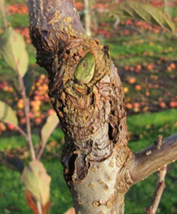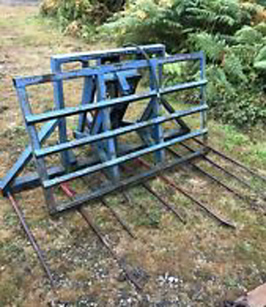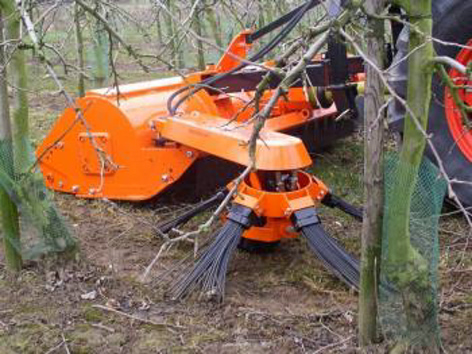

At the BIFGA Technical Day in January, Dr. Lucas Shuttleworth from NIAB/EMR presented an update on Canker research.
Below: Dr. Lucas Shuttleworth and right: a severe canker infection/wound and Spores


It does not matter who you speak to in the apple growing industry, in any country in the world, Canker is a common enemy. Canker can be so bad in some varieties/orchards that the only option is to grub the orchard.
As a former fruit grower with 60 year's practical experience of tree management, The English Apple Man has like all apple growers despaired at times when fighting canker infection. In the far of days of my youth when tree density was less, we would try to save the trees by removing the cankered branches and painting the saw cuts to seal off further infection. The next year the problem trees would fester with more canker, sometimes they would die and sometimes we did the sensible thing and removed the tree completely.
Back then I was growing predominately Cox Orange Pippin which was not as bad for canker as modern varieties like Gala, Kanzi and Jazz.
In today's world where tree densities are much greater with trees circa 0.8 - 1 metre apart, there is no point in trying to save a tree once canker has taken hold. Also in the 1950's/60's trees would stay in production for at least 25 years.
Today growers may only keep an orchard for 12/13 years based on 10 years of full production.
Research
The ongoing research for controlling canker has been going on for decades, with 'every so often' a new breakthrough or more accurately 'a better understanding of the canker beast' surfacing.
As a grower, I like many was convinced the infection came from the nursery as the 'source of infection' and no doubt that was true in some cases. We know an orchard which has suffered severe canker in the past is the last place to plant a canker susceptible variety.
Today we recognise the importance of orchard hygiene; the removal of overwintering canker spores on any prunings left in the orchard is a 'launch pad' for canker in the next growing season. Pruingin wet weather creates a high risk of spreading infection from one cut surface to another. Leaf abscission when canker spore are prevalent (wet & humid conditions) is another danger zone!
The risk factors are so high that one seriously wonders how we manage to avoid canker at all!
 Looking back 60 years when my family were primarily growing Cox Orange Pippin, pruning then was very much governed by a 'hand saw and secateurs' approach: ALL prunings were picked up by hand (by hard-working ladies) and lumped up in the alleyways where we men would collect them on a simple sledge made from a number of galvanised sheets wired to together, then taken out of the orchard and burnt.
Looking back 60 years when my family were primarily growing Cox Orange Pippin, pruning then was very much governed by a 'hand saw and secateurs' approach: ALL prunings were picked up by hand (by hard-working ladies) and lumped up in the alleyways where we men would collect them on a simple sledge made from a number of galvanised sheets wired to together, then taken out of the orchard and burnt.
In terms of hygiene - "very good practice"
In time we moved onto new, but simple technology!
The Buck rake fixed to the tractor's hydraulics allowed us to collect by 'sweeping' the prunings i initially the stacks of prunings, but soon with more intensive orchards sweeping the prunings where they lay from pruning. Less labour input, but on reflection, less hygienic!
Today, most growers would be sweeping leaves and prunings from beneath the trees and pulverising into very small matter capable of rotting down.
Below: in today's world - Perfect sweeper and Perfect chopper


Back to Dr. Shuttleworth's presentation
Under the umbrella of AHDB Agricultural & Horticulture Development Board which designates the funding for important research, much of which is carried out at NIAB EMR
Lucas Shuttleworth raised a number of target areas in Canker research: Rootstocks, Cold Storage of raised trees, Planting time, Scions (varieties susceptible to canker) Endophytes, Mycorrihza et al.
Project AHDB TF223 - Improving pest & disease management in tree fruit.
"Does rootstock have an effect on Canker - YES, depending on cultivar!
"Is there a vigour effect on reduced canker? - not clear!
The English Apple Man recognises that some Jazz growers have planted the variety on M26 ( slightly stronger rootstock than M9) due to its ability to cope with canker - it still gets canker, but copes better than M9.
Lucas raised the question of increase in canker infection when lifted trees are held for a long period in cold storage. A common practice for nurseries operating on a large scale. Young trees are kept moist by misting to avoid drying out, but this increases the risk of spreading canker infection in cold storage.
The English Apple Man remembers back in my younger days, we always bedded out the trees when they arrived in December - dug a trench (approx a spade depth and wide) and placed the bunches (ten in a bundle) into the trench and covered the roots with soil, always making sure the space in each bundle was filled with soil to ensure any frost would not reach the roots causing damage.
Planting would normally take place in January.
In the AHDB trial trees were planted on three sites in Kent.
First planting - In December 2018 immediately after lifting and second planting in April 2019.
Assess whether cold storage duration affects canker expression during the early establishment of a young orchard.
280 trees were planted on each site.
Seven scion cultivars were planted - Golden Delicious, Grenadier, Gala, Braeburn, Jazz, Kanzi & Rubens all planted on M9 337. Trees were inoculated with neonectria ditissima in the nursery during autumn 2018 at leaf fall.
M9 337 - This dwarfing rootstock, ideal for high-density plantings, produces a tree similar to EMLA 9 cropping early with large fruit size.
Canker incidence assessed in Autumn 2019.
Endophytic fungi reside inside the healthy tissues of plants. Endophytic fungi have the ability to benefit plant growth, metabolism and defence against pathogens, herbivores, insects, etc. They can produce various potential commercially valued secondary metabolites. This has generated worldwide interest among the researchers to study and exploit them for applications in pharmacy and agriculture. Extensive research has led to the discovery of endophytic fungi which provides a great source of medicine for therapeutic applications in human and plant protection under adverse conditions
Most endophyte-plant relationships are still not well understood. Endophytes and plants often engage in mutualism, with endophytes primarily aiding in the health and survival of the host plant with issues such as pathogens and disease, water stress, heat stress, nutrient availability and poor soil quality, salinity, and herbivory.
In exchange, the endophyte receives carbon for energy from the plant host. Plant-microbe interactions are not strictly mutualistic, endophytic fungi can potentially become pathogens or saprotrophs. Endophytes may become active and reproduce under specific environmental conditions or when their host plants are stressed or begin to senesce, thereby limiting the amount of carbon provided to the endophyte.
Endophytes may benefit host plants by preventing other pathogenic or parasitic organisms from colonizing them. Endophytes can extensively colonize plant tissues and competitively exclude other potential pathogens.
Some fungal and bacterial endophytes have proven to increase plant growth and improve overall plant hardiness.
Soil amendments to reduce canker
Effect of adding Arbuscular Mycorhizza fungi (AMF) plant growth-promoting rhizobacteria (PGPR) and Trichoderma on canker in newly planted orchards and rootstock stool bed.
Below: Expanded graph - number of Cankers per tree x treatment x position within tree/rootstock
Conclusions
An integrated approach using a number of techniques is needed to reduce canker.
These include variety selection, site selection, rootstock selection, planting time of young trees (December planting better than refrigeration and April planting) and addition of amendments such as Trichoderma with newly planted trees.
Further work needed for example on the effects of 'elicitors' and 'biostimulants' to increase host selection from canker.
That is all for this week: next week more from the BIFGA Technical Day ![]()
Take care
The English Apple Man